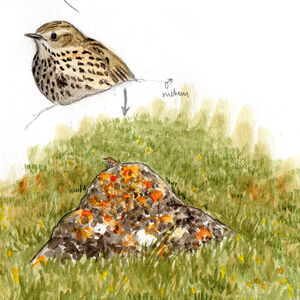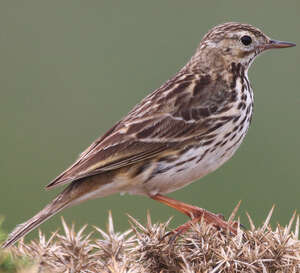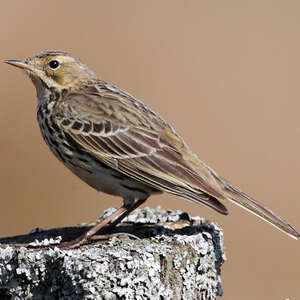Meadow Pipit
Anthus pratensis - Pipit farlouse
Identification
The Meadow Pipit is like the majority of pipits - a small, striped, brown bird, about 15cm in length with no particularly striking features, making its identification quite tricky. In its distribution area, there are 5 other bird species that look very similar. Voice is the best criteria (Chapter to follow) followed by a set of criteria which should all be positive for each one to be conclusive. Let us look at the adult, which has no sexual dimorphism.
Firstly, the head. The Meadow Pipit generally has an open face. The dark eye is surrounded by pale, the lores are pale, a faint pale eyebrow is above the eye, the cap is finely striped and a wide pale moustache starts at the beak and ends at the base of the neck. This moustache is above a blackish-brown band under the eye which is highlighted by a finer, clearer black line reaching a black zone on the sides of the neck. The chin and throat are white. The beak is quite thin with a yellow lower jaw. This head pattern loses its clarity throughout the spring.
Secondly, the mantle. In new plumage, it is clearly striped lengthways. On a beige-brown background, olive in tint, there alternate wide blackish-brown stripes and pale yellowish-brown ones. These should not be white or cream-ochre at most. In worn plumage, the mantle loses its contrasts, becomes dull and less typified.
Thirdly, the underparts. The background colour is white, with a russet tint in new plumage. This russet should not be limited to the chest but should also reach the belly and sides. At the rear of the sides, there is usually a darker, ruddier zone. With wear, the lower parts will pale until they are almost white. The chest is clearly marked with black stripes which continue along the sides and which usually form two neat black lines.The middle of the chest is often marked with an irregular black spot, a bit like members of the Nearctic family of buntings. Finally, the legs. They are usually pale, ranging from pink to rosy, sometimes yellowish and more rarely a light brown. The hind claw is very long, longer than the finger itself.
An additional criterion when it is seen, is the rump. The Meadow Pipit has a smooth rump in a tawny hue, with an olive tint, that contrasts well with the rest.
The juvenile has new plumage, darker and more red-brown than that of the adult, especially underneath.
To conclude, let's quickly look quickly at the other characteristics of the other pipits, which can help avoid confusion. In our area, in the summertime, the Tree Pipit is the main obstacle to avoid. In it, the reddish colour of the underside is limited to the chest and the stripes on the flanks are much finer than those on the chest.
At the time of migration, the young Red-throated Pipit looks a lot like the Meadow Pipit. You need to look at the mantle, which in it, features clear white epaulettes. In addition, the call is very different.
In the wintertime, the first winter Rock Pipit or the winter adult adds to the difficulty. The mantle of the Rock Pipit is always much more uniform, without clear stripes or with faint stripes. Generally, a clear white eyebrow above the eye. Its legs are dark, ranging from reddish to brownish, even blackish.
Let's leave aside the Petchora Pipit, which is very rare in France.
Subspecific information monotypic species
Foreign names
- Pipit farlouse,
- Bisbita pratense,
- petinha-dos-prados,
- Wiesenpieper,
- réti pityer,
- Graspieper,
- Pispola,
- ängspiplärka,
- Heipiplerke,
- ľabtuška lúčna,
- linduška luční,
- Engpiber,
- niittykirvinen,
- titella,
- Þúfutittlingur,
- świergotek łąkowy,
- pļavu čipste,
- travniška cipa,
- Луговой конёк,
- マキバタヒバリ,
- 草地鹨,
- ängspiplärka,
- 草地鷚,
Voice song and call
The song of the Meadow Pipit is typically a pipit song. It is emitted during the mating flight. The singer sits on an elevated perch, shrub or post, on which it starts to sing before taking off and returning to after gliding. The song does not have the power of the Tree Pipit, but is more liquid, finer and rather evokes the song of the Rock Pipit which is in the mountains in a rocky environment.
The most frequent call, often emitted at takeoff, is a sharp psit, often repeated twice or three times. It does not have its equivalent among other Anthus.
The alarm cry near the nest from the adults is a strong tsip, which can double into psitip when the concern increases.
Habitat
Meadow Pipit is a bird of open and semi-open wetland environments from sea level up to quite high mountains depending on available habitats. It can be found in coastal marshes, dunes, salt marshes, saline meadows, hay meadows in river valleys, large inland marshes, heaths, bogs, wet pastures, fallows and locally untended mesotrophic meadows, forest clearings, etc. In winter it frequents the same environments but also many agricultural spaces, and this in groups.
Behaviour character trait
The origin of the genus name Pipit (pipi or pipit or pitpit) comes from the call of these birds. The origin of the specific name farlouse is unknown, but the term was already used by Belon in 1555.
As for the name Meadow Pipit formerly given to it, it is simply the literal translation of the Latin word pratensis meaning of the meadows, prairial.The Meadow Pipit is sedentary or rather erratic, or migratory depending on the climatic conditions. They become gregarious after reproduction. In France, it is present everywhere in winter in favorable environments where local and migrating birds from the east come together.
As much as a single Meadow Pipit can be discreet, so a interbreeding flock in flight is not overlooked, especially since the many cries emitted then attract attention. The bulk of their activity is on the ground. It is on the ground that they look for their food. In case of alarm, for example due to the occurrence of a sparrowhawk, the whole flock will take refuge in woody, shrubs, hedges, thickets, where the birds feel safe. Once the danger is past, the group gradually returns to the ground, the least fearful in the first place.
Flight
Meadow Pipit flight is a typically pipit flight. Already, the silhouette is a good indication. Pipits have very extended tertiaries which gives their wings a slightly triangular shape, which can be seen.
The surrounding and the period can also help with its identification. Furthermore, as with many other birds, they have a undulating flight, their wings beating rhythmically. You have to identify the species and there, it's mainly by its call that you identify the species, and a bit by its look as well.The nuptial flight is carried out by the reproductive male. This is a territorial flight with its singing throughout the flight and different phrasing for each part of the flight. The flight begins with a slow ascent from a perch, its wings vibrating, a bit like the Skylark. Followed by a circular flight of recognition above the territory, still accompanied by its song, for a few tens of seconds. Then the bird drops itself back to its initial perch with an oblique gliding flight called parachute while still emitting its last syllables.
Dietfeeding habits
The Meadow Pipit is mainly insectivorous, and in all seasons. It mainly consumes small prey, depending on the size of its beak.
It looks for such prey directly on the ground, in low vegetation, or in any environment which can provide it such as dune slacks, dung heaps, etc. These preys come from all types of invertebrates, various insects and their larval forms, spiders, myriapods, small terrestrial crustaceans, small earthworms, small mollusks, etc. To a lesser extent, it also consumes seeds in the interseason, small seeds from grasses, cyperaceae, rush or heathers.Reproduction nesting
The Meadow Pipit is monogamous and territorial for breeding. Depending on the latitude, the breeding season ranges from March to August.
In Central Europe, it starts in April and the birds have enough time for two successive clutches, which is not the case in the northern part of the range.The Meadow Pipit has a small territory (about 25 ares), which allows for a high specific density. While the male defends the territory, the female builds a cup-shaped nest composed of dry grass, moss loosely assembled but well hidden under a tuft of grass or a small bush, such as heather. The interior of the cup, more carefully arranged, is lined with horsehair and fur. The female lays 4-5 eggs (2-7) olive heavily spotted with reddish brown, which she incubates alone for 13 days. Then follows a 15-day fishment in the nest, where both the members of the couple participate. Since the nest is on the ground, it is common for the young to leave prematurely, before being able to fly.
Geographic range
The Meadow Pipit has mainly a European distribution during the breeding season. It can be found from East Greenland to Western Siberia, including Iceland, the British Isles, and across Northern Europe to the Arctic Ocean and the Kara Sea in Russia. A particular subspecies, ssp whistleri, occupies a small part of this range, namely Iceland, the Faroe Islands, and Scotland.
The wintering range is largely disjunct due to climatic reasons. Basically, the birds from the North (Greenland, Iceland, Fennoscandia, Northern Europe, and Russia) are migratory. The migrating groups head SE in September and October for the North Atlantic ones, south and southwest for the others, and come to spend the bad season in Western Europe with the local sedentary birds, as well as around the Mediterranean basin, the Black Sea coasts, south of the Caspian Sea in Iran, and down to South Central Asia.
Threats - protection
IUCN conservation status
concern
in the Wild
threatened
evaluated
The Meadow Pipit is not globally threatened as a species due to its immense distribution range. Nevertheless, a marked decline has been observed since the second half of the twentieth century in Europe, estimated at 25-30%. To such an extent that recently it has been classified as near threatened. The reasons are easy to imagine, climate change, changes in farming practices (early mowing, ensilage, various inputs, etc.), in particular.
Sources of information
- IOC World Bird List (v15.1), Gill, F and D Donsker (Eds). 2025-12-07.
- Les passereaux d'Europe, tome 1, P. Géroudet, M. Cuisin
- Birds of the World, The Cornell Lab of Ornithology
- xeno-canto, Sharing bird sounds from around the world,
Other sources of interest
 Specification sheet created on
22/07/2023 by Jean François
Specification sheet created on
22/07/2023 by Jean FrançoisTranslation by AI Oiseaux.net
© 1996-2026 Oiseaux.net
- Accipitriformes
- Aegotheliformes
- Anseriformes
- Apodiformes
- Apterygiformes
- Bucerotiformes
- Caprimulgiformes
- Cariamiformes
- Casuariiformes
- Charadriiformes
- Ciconiiformes
- Coliiformes
- Columbiformes
- Coraciiformes
- Cuculiformes
- Eurypygiformes
- Falconiformes
- Galliformes
- Gaviiformes
- Gruiformes
- Leptosomiformes
- Mesitornithiformes
- Musophagiformes
- Nyctibiiformes
- Opisthocomiformes
- Otidiformes
- Passeriformes
- Pelecaniformes
- Phaethontiformes
- Phoenicopteriformes
- Piciformes
- Podargiformes
- Podicipediformes
- Procellariiformes
- Psittaciformes
- Pterocliformes
- Rheiformes
- Sphenisciformes
- Steatornithiformes
- Strigiformes
- Struthioniformes
- Suliformes
- Tinamiformes
- Trogoniformes


































